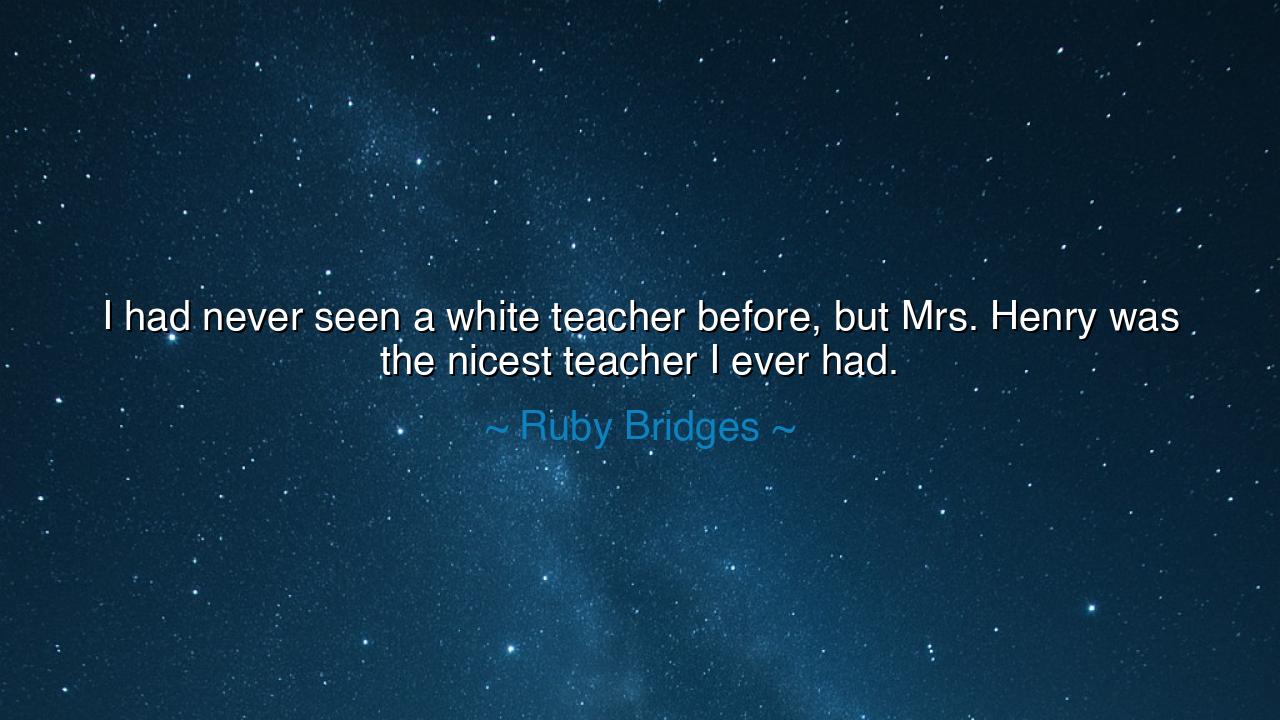
I had never seen a white teacher before, but Mrs. Henry was the
I had never seen a white teacher before, but Mrs. Henry was the nicest teacher I ever had.






Ruby Bridges, child of courage and symbol of a nation’s awakening, once spoke these words: “I had never seen a white teacher before, but Mrs. Henry was the nicest teacher I ever had.” At first glance, these are the words of innocence, the simple recollection of a young girl. Yet within them lies a truth both profound and eternal: that kindness has the power to pierce the walls of hatred, and that the bond between teacher and student can transcend the chains of race, fear, and prejudice.
The origin of this quote flows from the crucible of the Civil Rights Movement in America. In 1960, Ruby Bridges became the first African American child to integrate an all-white elementary school in New Orleans. She was only six years old, yet her walk to school required federal marshals at her side, for mobs cursed and threatened her. In the midst of this storm, Ruby encountered Mrs. Barbara Henry, a white teacher from Boston, who welcomed her not with fear nor disdain, but with open arms. For an entire year, Mrs. Henry taught Ruby alone, in a classroom emptied by parents who withdrew their children in protest. And Ruby, who had never before seen a white teacher, discovered in her not hostility, but kindness.
This story shines like a beacon in the night. Where others saw division, Ruby and Mrs. Henry saw humanity. Where the crowd shouted with rage, the teacher offered gentleness. Where history might have been scarred only with bitterness, the seeds of compassion were sown instead. Ruby’s words remind us that the healing of a nation does not only come through laws and speeches, but also through small acts of dignity — the courage of a child to walk forward, and the courage of a teacher to embrace her student without hesitation.
History gives us many such echoes. Consider Anne Sullivan, who entered the life of a blind and deaf child, Helen Keller, whom others thought unreachable. With patience and love, Sullivan broke through the walls of silence, teaching Helen not only words, but life itself. Just as Ruby saw in Mrs. Henry a light that crossed the boundaries of race, Helen saw in Anne Sullivan a guide who crossed the barriers of isolation. In both stories, the teacher stood as a bridge — one between races, the other between silence and speech.
The lesson is clear: the work of a teacher is not merely to impart knowledge, but to reveal humanity. A true teacher tears down walls — whether of ignorance, of prejudice, or of despair. Ruby Bridges reminds us that kindness and courage in the classroom can become weapons sharper than swords, shaping not only the lives of children but the soul of society itself. For when the child who is despised finds love in her teacher, the cycle of hate begins to break.
What, then, shall we practice? Let us see each child not through the lens of division, but through the light of possibility. Let us, whether we are teachers, parents, or mentors, remember that one act of kindness may alter a life, and through that life, alter history. Let us train our hearts to look past prejudice, to welcome the stranger, to embrace the outcast, to say with our deeds what Mrs. Henry said to Ruby through her presence: “You belong here.”
Therefore, O seekers of truth, remember Ruby’s words. The world may rage with hatred, but the classroom can be a sanctuary of hope. The world may cry “division,” but a teacher can whisper “unity.” And when a child who has never seen kindness from the other side encounters it for the first time, the soul awakens to a new vision of humanity. In this lies the triumph of compassion, the power of education, and the promise of a better tomorrow.






AAdministratorAdministrator
Welcome, honored guests. Please leave a comment, we will respond soon